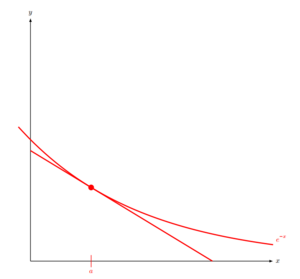Science:Math Exam Resources/Courses/MATH100 A/December 2023/Question 28(a)
{{#incat:MER QGQ flag|{{#incat:MER QGH flag|{{#incat:MER QGS flag|}}}}}}
• Q1 • Q2 • Q3 • Q4 • Q5 • Q6 • Q7 • Q8 • Q9 • Q10 • Q11 • Q12 • Q13 • Q14 • Q15 • Q16 • Q17 • Q18 • Q19 • Q20 • Q21 • Q22 • Q23 • Q24 • Q25 • Q26 • Q27(a) • Q27(b) • Q27(c) • Q28(a) • Q28(b) • Q29(a) • Q29(b) • Q30 •
Question 28(a) |
|---|
|
Let
The goal of this question is to find the number such that the triangle consisting of the portion of the first quadrant that lies below the tangent line to at has the largest possible area. Part A: Draw a large sketch of the function and the region in question, making sure to label the value . |
|
Make sure you understand the problem fully: What is the question asking you to do? Are there specific conditions or constraints that you should take note of? How will you know if your answer is correct from your work only? Can you rephrase the question in your own words in a way that makes sense to you? |
|
If you are stuck, check the hint below. Consider it for a while. Does it give you a new idea on how to approach the problem? If so, try it! |
Hint |
|---|
|
Is increasing or decreasing with ? Find also the inflection points to determine the concavity of the graph. |
|
Checking a solution serves two purposes: helping you if, after having used the hint, you still are stuck on the problem; or if you have solved the problem and would like to check your work.
|
{{#incat:MER CT flag||
}}












